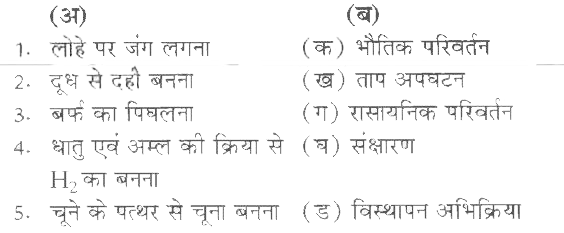निम्नलिखित समीकरणों को सन्तुलित कीजिए-
CH4(g)+O2(g)→CO2(g)+H2O
CH4(g)+2O2(g)→CO2(g)+2H2O(l)
Topper's Solved these Questions
- रासायनिक अभिक्रियाएँ एवं उत्प्रेरक Book:SANJEEV PUBLICATIONChapter:रासायनिक अभिक्रियाएँ एवं उत्प्रेरक Exercise:अन्य महत्त्वपूर्ण प्रश्नोत्तर (सुमेलन संबंधी प्रश्न)
Explore 2 Videos
- रासायनिक अभिक्रियाएँ एवं उत्प्रेरक Book:SANJEEV PUBLICATIONChapter:रासायनिक अभिक्रियाएँ एवं उत्प्रेरक Exercise:अन्य महत्त्वपूर्ण प्रश्नोत्तर (लघूतरात्मक प्रश्न)
Explore 26 Videos
- रासायनिक अभिक्रियाएँ एवं उत्प्रेरक Book:SANJEEV PUBLICATIONChapter:रासायनिक अभिक्रियाएँ एवं उत्प्रेरक Exercise:अन्य महत्त्वपूर्ण प्रश्नोत्तर (वस्तुनिष्ठ प्रश्न)
Explore 10 Videos
- रासायनिक अभिक्रियाएँBook:SANJEEV PUBLICATIONChapter:रासायनिक अभिक्रियाएँExercise:अन्य महत्त्वपूर्ण प्रश्न (अतिलघुत्तरात्मक प्रश्न)
Explore 37 Videos
Similar Questions
निम्नलिखित को सुमेलित कीजिए-
(i)बर्फ का पिघलना(A)एन्जाइम(ii)उपापचयी (रेडॉक्स) अभिक्रिया(B)भौतिक परिवर्तन(iii)जैव उत्प्रेरक(C)CuO(s)+H2(g)→Cu(s)+H2O(l)
View Solutionनिम्नलिखित रासायनिक समीकरणों में-
C+O2→CO2 ...(i)
2H2Oविधुतधारा−−−−−→2H2+O2 ...(ii)
(अ) रासायनिक समीकरण (i) तथा (ii) को पहचानकर उसका प्रकार लिखिए |
(ब) समीकरण (i) तथा (ii) में कोई एक अंतर् लिखिए |
(स) उत्प्रेरक विष तथा उत्प्रेरक वर्धक में एक अंतर लिखिए |
View Solutionजब पोटेशियम धातु की जल से क्रिया करवाते हैं तो इसका-
View Solutionनिम्न को सुमेलित कीजिए

View SolutionBased on the following thermochemical equations H_(2)O(g)+C(s)rarrCO(g)+H_(2)(g),DeltaH=131KJ CO(g)+1//2O_(2)(g)rarrCO_(2)(g),DeltaH=-282KJ H_(2)(g)+1//2_(2)(g)rarrH_(2)O(g),DeltaH=-242KJ C(s)+O_(2)(g)rarrCO_(2)(g),DeltaH=XKJ The value of X will be
View SolutionFor the following three reaction 1, 2 and 3, equilibrium constants are given: (1) CO_((g)) + H_(2)O_((g))hArrCO_(2(g)) + H_(2(g)), K_(1) (2) CH_(4(g)) + H_(2)O_((g))hArrCO_((g)) + 3H_(2(g)), K_(2) (3) CH_(4(g)) + 2H_(2)O_((g))hArrCO_(2(g)) + 4H_(2(g)), K_(3) Which of the following relations is correct ?
View SolutionWhich of the following is a controlled oxidation reaction?
A: CH4(ag)+2O2(ag)→CO2(g)+2H2O((l))
B: CH4(g)+O2(g)→C(s)+2H2O(l)
C: CH4(g)+O2(g)Mo2O3→HCHO+H2O(l)
D: CH4(g)+O2(g)Cu/523K/100atm−−−−−−−−−−−→2CH3OH(l)
View SolutionGiven Cs+O2(g)→CO2(g),ΔH=−94.2Kcal
H2(g)+½O2(g)→H2O(g),Δ=−68.3Kcal
CH4(g)+2O2(g)+2H=−210.8Kcal
what will be heat of gormation of CH4 in (Kcal) ?
View SolutionThe mechanism of the reaction 2NO(g)+H_(2)(g)rarrN_(2)(g)+2H_(2)O(g) , is: Step1: 2NO(g)+H_(2)(g)overset(("slow"))rarrN_(2)+H_(2)O_(2) Step2: H_(2)O_(2)+H_(2)overset("fast")rarr2H_(2)O
View SolutionFor the following three reaction 1, 2 and 3, equilibrium constants are given:
(1) CO(g)+H2O(g)⇔CO2(g)+H2(g),K1
(2) CH4(g)+H2O(g)⇔CO(g)+3H2(g),K2
(3) CH4(g)+2H2O(g)⇔CO2(g)+4H2(g),K3
Which of the following relations is correct ?
View SolutionThermochemical reactions
C(graphite)+12O2(g)→CO(g),ΔH=−110.5kJ
CO(g)+12O2(g)→CO2(g),ΔH=−283.2kJ
From the above reaction, the heat of reaction for C(graphite) +O2(g)→CO2(g) will be
View SolutionGiven that C(s)+O_(2)(g)rarrCO_(2)(g), DeltaH=-394 kJ 2H_(2)(g)+O_(2)(g)rarr2H_(2)O(l), DeltaH=-568kJ CH_(4)(g)+2O_(2)(g)rarrCO_(2)(g)+2H_(2)O(l)DeltaH=-892 kJ Heat of formation of CH_(4) is
View SolutionC(s)+O_(2)(g)rarrCO_(2), DeltaH=-94 kcal CO(g)+(1)/(2)O_(2)(g)rarrCO_(2), DeltaH=+135.2 kcal Then heat of formation of CO(g) is
View SolutionC(graphite)+O2(g)→CO2(g),ΔH=−94.05kcalmol−1
C(diamond)+O2(g)→CO2(g),ΔH=−94.50kcalmol−1 therefore
View SolutionCgraphite+O2(g)→CO2(g),+95.450cal.
View Solution

